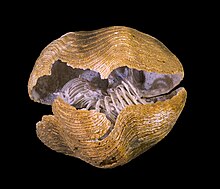Thelophophore(/ˈlɒfəˌfɔːr,ˈloʊfə-/)[1]is a characteristic feedingorganpossessed by four major groups ofanimals:theBrachiopoda,Bryozoa,Hyolitha,andPhoronida,which collectively constitute theprotostomegroupLophophorata.[2]All lophophores are found in aquatic organisms.



Etymology
editLophophoreis derived from the Greeklophos(crest, tuft) and-phore,-phoros(φορος) (bearing), a derivative ofphérein(φέρειν) (to bear); thus crest-bearing.
Characteristics
editThe lophophore can most easily be described as a ring ofciliatedtentacles surrounding the mouth, but it is often horseshoe-shaped or coiled. Phoronids have their lophophores in plain view, but the valves of brachiopods must be opened wide to get a good view of their lophophore.
The lophophore surrounds the mouth and is an upstream collecting system for suspension feeding. Its tentacles are hollow, with extensions of acoelomicspace thought to be amesocoel.The gut is U-shaped with the anterior mouth at the center of the lophophore. Theanus,where present, is also anterior, but is dorsal to the mouth. In theBryozoa,it is outside the ring of the lophophore. The inarticulatebrachiopodsdo not have an anus.
Classification of lophophorates
editGroups with lophophores are calledlophophorates.In the old view ofmetazoanphylogeny,the lophophorates were placed within theDeuterostomia.Now,[when?]they have been reassessed and placed in a newsuperphylumknown as theLophotrochozoa[3]in theProtostomia,which includes theMolluscaandAnnelida.
Newer phylogeny place the bryozoans in the group Polyzoa, which also includesentoproctansand Cycliophora, while molluscs,brachiozoansand annelids make up their own group, with brachiozoans and annelids as possible sister taxa.[4][5]
The extincthederelloids,microconchids,cornulitids,andtentaculitidswere likely lophophorates based on their biomineralization.[6]
The position of theHyolithahas long been disputed, but as of 2017, it has been assigned to the Lophophorata as finely-preserved specimens in theBurgess Shalecan be seen to carry lophophores.[7]Lophophorates did appear paraphyletic, but that is contested.[8][9][10]
References
edit- ^"lophophore".Dictionary Unabridged(Online). n.d.
- ^Introduction to the Lophotrochozoa– Retrieved 3 May 2010
- ^Giribet, G. (2008)."Assembling the lophotrochozoan (=spiralian) tree of life".Philosophical Transactions of the Royal Society of London. Series B, Biological Sciences.363(1496): 1513–1522.doi:10.1098/rstb.2007.2241.PMC2614230.PMID18192183.
- ^Polyzoa is back: The effect of complete gene sets on the placement of Ectoprocta and Entoprocta
- ^Armoured worm reveals the ancestry of three major animal groups
- ^Taylor, P.D.; Vinn, O.; Wilson, M. (2010)."Evolution of biomineralization in 'lophophorates'".Special Papers in Palaeontology.84:317–333.Retrieved11 June2014.
- ^Moysiuk, Joseph; Smith, Martin R.; Caron, Jean-Bernard (2017)."Hyoliths are Palaeozoic lophophorates"(PDF).Nature.541(7637): 394–397.doi:10.1038/nature20804.PMID28077871.S2CID4409157.
- ^Passamaneck, Y.; Halanych, K.M. (July 2006). "Lophotrochozoan phylogeny assessed with LSU and SSU data: evidence of lophophorate polyphyly".Mol Phylogenet Evol.40(1): 20–28.CiteSeerX10.1.1.136.6365.doi:10.1016/j.ympev.2006.02.001.PMID16556507.
- ^Struck, Torsten H.; Wey-Fabrizius, Alexandra R.; Golombek, Anja; Hering, Lars; Weigert, Anne; Bleidorn, Christoph; Klebow, Sabrina; Iakovenko, Nataliia; Hausdorf, Bernhard (1 July 2014)."Platyzoan Paraphyly Based on Phylogenomic Data Supports a Noncoelomate Ancestry of Spiralia".Molecular Biology and Evolution.31(7): 1833–1849.doi:10.1093/molbev/msu143.ISSN0737-4038.PMID24748651.
- ^Nesnidal, Maximilian P.; Helmkampf, Martin; Meyer, Achim; Witek, Alexander; Bruchhaus, Iris; Ebersberger, Ingo; Hankeln, Thomas; Lieb, Bernhard; Struck, Torsten H. (17 November 2013)."New phylogenomic data support the monophyly of Lophophorata and an Ectoproct-Phoronid clade and indicate that Polyzoa and Kryptrochozoa are caused by systematic bias".BMC Evolutionary Biology.13:253.doi:10.1186/1471-2148-13-253.ISSN1471-2148.PMC4225663.PMID24238092.